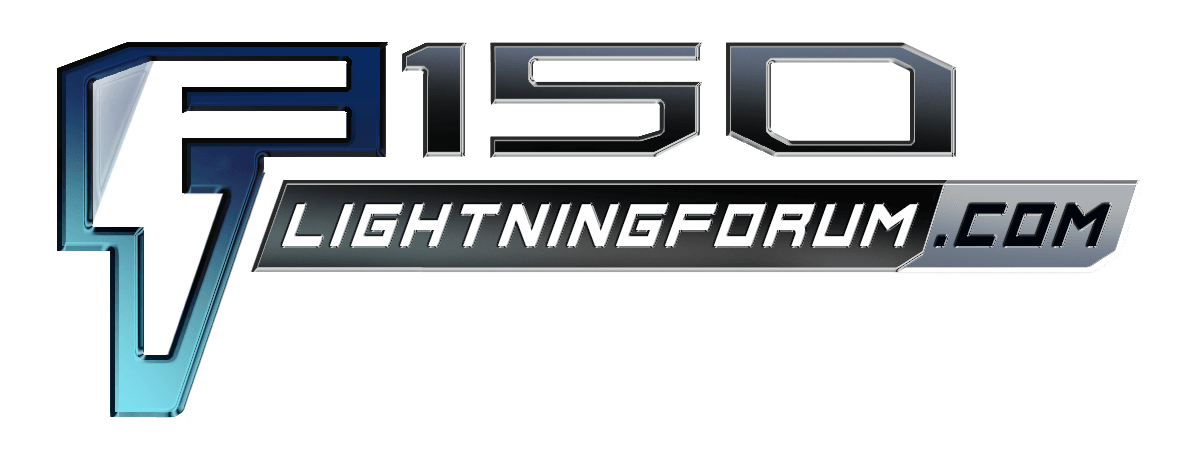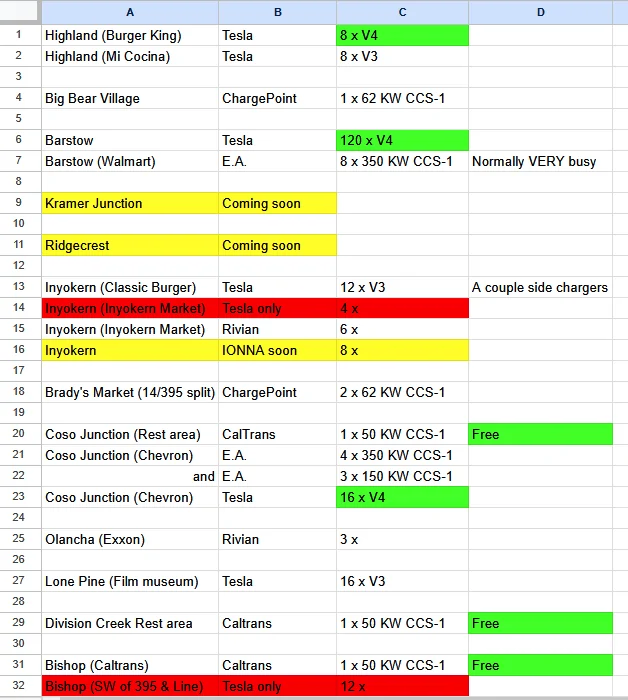K6CCC
Well-known member
- First Name
- Jim
- Joined
- Sep 12, 2024
- Threads
- 23
- Messages
- 601
- Reaction score
- 560
- Location
- Glendora, Calif.
- Vehicles
- 2024 Lightning Flash ER in Antimatter Blue, 2017 Toyota Corolla (wife's car)
- Occupation
- Retired from 2-Way radio systems
- Thread starter
- #1
Every year I help support a five day bicycle ride from Big Bear to Mammoth Mtn in California. The 335 mile ride is a fund raiser for a charity in Big Bear. I also did a little GeoCaching along the way and more on the way to Big Bear and on the way home. This was the first year driving my Lightning, so I’m going to tell you about it. Warning, this will get a bit long.
As a support person, there are a few interesting challenges. For example, although the longest day for the riders is just under 80 miles, for the support drivers, we never know really how far we will need to drive. As a result, I wanted to start each day at least fairly well charged. Prior to the ride I had done my homework and knew that there were plenty of fast chargers along the route and also some places I could potentially get free charging. One of my additional plans was to find and check out at least most of the fast charging locations along the way even if I did not stop to charge.
I will intersperse locations with latitude and longitude that you plug into Goggle Earth if you want to see where they are. I also added elevation as that does play into the story. The ride is listed as Day 1 through Day 5, and the drive to Big Bear is Day 0 and the drive home after the ride is Day 6.
Day 0 – 7 Oct. 2025 – Home to Big Bear
Departed home in Glendora, CA with 100% charge. Route eastbound I-210 to CA Hwy 330 in Highland. Exited at Highland Blvd. in order to locate the two Tesla SuperChargers there. I did not need a charge as I was only down to 90%, but wanted to locate them. There is an 8 bay V3 charger that had two in use. The other charger is an 8 bay V4 that was completely open. Both are open to non-Tesla vehicles. After checking out the SuperChargers, I grabbed lunch.
Near home 34° 06' 49.91"N 117° 50' 47.15"W Ele. 793'
Between the two Highland SuperChargers 34° 08' 08.68"N 117° 11' 43.96"W Ele. 1478'
After leaving Highland, Hwy 330 does a lot of up hill. Highland is about 1500 feet and the highest elevation on Hwy 330 is about 7150 feet. I was very interested in how the hill climbing would affect power consumption, so I reset one of the trip meters. After getting to Big Bear and a little running around, the 41.3 miles had averaged 1.4 miles / KWH. Big Bear has a Tesla SuperCharger that is Tesla only and a bunch of L2 chargers. There is exactly one 50 KW ChargePort charger in town that was close to my motel, but I did not need it. It was also busy when I checked. I finished the day with 80.8 miles for the day at 68% charge and an average of 1.7 miles / KWH. The GOM showed range of 188 miles.
Start of day: 100% - 323 miles
Day: 80.6
Trip: 80.6
End of day: 68% - 182 miles
Motel in Big Bear - 34° 14' 35.24"N 116° 54' 42.05"W Ele. 6775'


Day 1 – 8 Oct. 2025 - Big Bear to Hinkley
Drove the couple miles from my motel to the start location at the Bear Mtn Ski resort. Then a few miles of the ride before starting down the steep hill on CA Hwy 18 on the backside of Big Bear. I wanted to see what the regen would do going down the hill, so I noted the numbers at the top and again most of the way down. At the top I was at 64% and 169 miles on the GOM at 6849 feet. 11.4 miles later at 3195 feet I was at 68% and 182 miles range. After mostly getting down the hill, on to Lucerne Valley and CA Hwy 247 into Barstow with a little detour for some GeoCaching. There is one pretty good hill before lunch and smaller one after lunch. In Barstow, I detoured to Walmart for a couple items and to check out the Electrify America station in the parking lot. Amazingly, it had two open stalls (that one is usually full) then back to the 120 stall Tesla SuperCharger for a charge. After the charge I had to double back to pick up a rider and take them and their bike to our first overnight spot. I took the freeway rather than the route that the riders took.
Start of day: 68% - 182 miles
Day: 84.9
Trip: 165.6
Barstow Tesla 52% - 83% (43 KWH)
End of day: 78% - 221 miles
Overnight in Hinkley 34° 54' 04.92"N 117° 10' 15.04"W Ele. 2861'


Day 2 – 9 Oct 2025 - Hinkley to Ridgecrest.
The day 2 ride is mostly west on CA Hwy 58 and north on US HWY 395. There is a lot of hill climbing and one steep drop. When passing through Kramer Junction, I looked at all three locations shown on PlugShare as future DCFC location. None show any indication that there will be anything there – yet. At Ridgecrest we camp in the county fairgrounds and as expected I was able to charge from a RV outlet. It was 208 volts unloaded and when charging about 195 volts so fairly slow with the mobile charge cord, but I was there for almost 16 hours so that did not matter. Because it was free, I charged to 100%.
Start of day: 78% - 221 miles
Day: 71.6 1.9 Mi/KWH
Trip: 237.2 2.1 Mi/KWH
End of day: 49% (did not note the GOM range)
Overnight charge 49% - 100% (66 KWH)
Overnight in Ridgecrest 35° 36' 44.86"N 117° 38' 46.69"W Ele. 2278'


Day 3 – 10 Oct. 2025 - Ridgecrest to Lake Diaz (near Lone Pine)
Leaving Ridgecrest, we head west to InyoKern and then north on a side road to avoid the 396 traffic for a while. Across the street from our turn are three DCFC stations – two Tesla (both V3) with a 4 stall that is Tesla only and a 12 stall that is open to non-Tesla vehicles, and a 6 stall Rivian charger that is open to non-Rivian vehicles. The SuperCharger was my backup in case I had not been able to charge at the fairgrounds. Our lunch stop on day 3 is the Coso Junction rest area. The California Department of Transportation (CalTrans) has been installing free 50 KW EV chargers (one CCS-1 and one CHAdeMo cable) at many of the rest areas. Although I did not need a charge, I plugged in to make sure it worked. After lunch we continue up 395 to a small campground on the banks of Lake Diaz. It’s a fairly primitive campground with no power, so our dinner crew is dependent on the two food RVs for power for a table full of crock pots and an electric frying pan. A perpetual problem with that every year is tripping breakers on the RV circuit. To solve that problem, I ran my heavy duty 100 foot 120V extension cord over to the table and powered five of the crock pots and the frying pan from the bed inverter. In the morning, both Keurig coffee makers were plugged into my truck. Worked FAR better than the RV generators. Note, the problem was the breakers for the outside outlets, not generator capacity. Overnight, I sleep with a CPAP so that was plugged into the truck inverters. Because of the issue where the truck shuts off the inverters if there is not enough load when the truck is turned off, I left the truck on overnight with the stereo, climate, and displays off. Between the dinner, my overnight, and the coffee makers, I dropped 6% of battery capacity while in camp.
Start of day: 100% - 293 Mi. range
Day: 82.4 1.9 Mi/KWH
Trip: 319.6 2.0 Mi/KWH
End of day: 76% - 209 Mi range
Overnight at Lake Diaz 36° 33' 30.07"N 118° 03' 26.92"W Ele. 3690'


Day 4 – 11 Oct. 2025 - Lake Diaz to Bishop
The fourth day is mostly headed north on Hwy 395 then west in Bishop to a campground on the west end of town. Because of road construction, we could not get to our normal lunch stop, so we lunched at the Division Creek rest area. That location also has a CalTrans free 50 KW charger. It was available so I charged up until a Tesla M3 showed up. I asked the driver and he said it was pretty desperate for a charge so I unplugged so he could charge. See, I can be a nice guy… After lunch, headed north to Bishop. I had planned on topping off at the Tesla SuperCharger in town, but I was early and was able to plug in to the CalTrans 50KW charger at the District 9 office in the south end of town -free is better... Once I got set up in camp, I made a run over to the Verizon store because my cellphone was having a dying SIM card. Turns out that the 6 stall Rivian charger was in the same parking lot. That changer is open to non-Rivian vehicles. Back to camp and again I used the truck inverter to power my CPAP overnight.
Start of day: 70% - 186 Mi. range
Day: 68.9 2.0 Mi/KWH
Trip: 388.6 1.9 Mi/KWH
Division Creek rest area 59% - 94% (50 KWH)
CalTrans dist. 9 office 81% - 95% (21 KWH)
End of day: 93% - 256 Mi. range
Overnight in Bishop: 37° 21' 43.51"N 118° 26' 25.51"W Ele. 4322'


Day 5 – 12 Oct. - Bishop to Mammoth Mtn.
The last day of the ride takes the riders over the old road through Round Valley and Paradise rather than up Sherwin Grade on Hwy 395. This is a beautiful route and keeps the slow moving bikes off the fast traffic highway for most of the day. We lunch at Tom’s Place and then more side roads to keep the riders mostly off 395. All the bikes meet up in the town of Mammoth Lakes and ride up together to the Mammoth Mtn. Inn to complete the 335 mile ride. This is the shortest mileage day of the ride, but includes over a mile of climbing. I did have to carry one rider up to the meet up location than drove back to find both Tesla SuperChargers in town. One is an 8 stall V3 that is Tesla only and the other is 12 stall V3 that is open to non-Tesla vehicles. After checking out the chargers, I drove back a little ways to pick up another rider to take her to the meet up location. Then the last 4 miles up to the Mammoth Mtn. Inn.
Start of day: 87% - 225 miles
Day: 67.3 1.6 Mi/KWH
Trip: 455.9 1.8 Mi/KWH
End of day: 56% - 128 range
End of the ride: 37° 39' 04.10"N 119° 02' 14.05"W Ele. 8898'


Day 6 – 13 Oct. 2025 - Mammoth Mtn to home
When I left Mammoth Mtn, it was 30 degrees in blowing snow. I was glad to get down a bit lower when the snow stopped. As I passed through Bishop I checked out the 24 stall Tesla SuperCharger on the north end of town that is open to non-Tesla vehicles, and the 4 stall E.A. charger. Both were completely vacant. After a stop at Erick Schat’s Bakkery for some great bread, I planned to stop by the CalTrans Dist. 9 office if it was available while I walked across the street for breakfast. But alas, another car just beat me to it, so I grabbed breakfast and continued south. Did some running around for some GeoCaching in Independence, around the Manzanar Relocation Center, and the north end of Lone Pine before pulling into the 16 stall V3 Tesla SuperCharger for lunch and a charge. I wanted to get enough charge to make it home so I charged to 95% Sure gets slow when the battery is that full! After the charge, did some more GeoCaching in Lone Pine before resuming the drive south. Several hours later I pulled into the Coso Junction rest area (for the facilities). The 50 KW charger was available so plugged in for the few minutes I was there. Did a little detour for a few GeoCaches in Randsburg and a dinner stop at Kramer Junction. Finally got home about 2115.
Start of day: 54% - 115 miles
Day: 330.4 2.3 Mi/KWH
Trip: 796.8 2.0 Mi/KWH
Tesla Lone Pine 17% - 95% (103 KWH)
Coso Junction rest area 77% - 82% (9 KWH)
End of day: 20% - 42 miles
When I got home I plugged into my FCSP to charge back to 100%
Home FCSP 20% - 100% (105 KWH)


Charging summary (subscription with Tesla):
Barstow Tesla 52% - 83% (43 KWH) @ $0.43/KWH = $18.67 - Average rate 117.27 KW
Ridgecrest fairgrounds 49% - 100% (66 KWH) @ free - Average rate 4.53 KW
Coso Junction rest area 85% - 80% (7 KWH) @ free - Average rate 42.00 KW
Division Creek rest area 59% - 94% (50 KWH) @ free - Average rate 41.68 KW
CalTrans Dist. 9 office 81% - 95% (21 KWH) @ free - Average rate 38.38 KW
Lone Pine Tesla 17% - 95% (103 KWH) @ $0.46/KWH = $49.79 - Average rate 80.26 KW
Coso Junction rest area 77% - 83% (9 KWH) @ free - Average rate 41.54 KW
Home FCSP 20% - 100% (105 KWH) @ $0.27/KWH = $28.35
Peak charging rate at both Tesla chargers was about 185 KWH.
Having the Tesla subscription saved me $26.88 so more than paid for the monthly subscription cost – and I have another trip next weekend where I expect to charge twice at Tesla SuperChargers.
Total 796.8 miles using 404 KWH at a cost of $96.81. Average was 2.0 miles / KWH which is well below my average of 2.3 since I've owned the truck, but involved faster driving, lots of hills, leaving the climate control on most of the time I was on the road, and the in camp inverter loads.
Overall, it was a good trip. I was never at all concerned about being able to charge the truck.
As a support person, there are a few interesting challenges. For example, although the longest day for the riders is just under 80 miles, for the support drivers, we never know really how far we will need to drive. As a result, I wanted to start each day at least fairly well charged. Prior to the ride I had done my homework and knew that there were plenty of fast chargers along the route and also some places I could potentially get free charging. One of my additional plans was to find and check out at least most of the fast charging locations along the way even if I did not stop to charge.
I will intersperse locations with latitude and longitude that you plug into Goggle Earth if you want to see where they are. I also added elevation as that does play into the story. The ride is listed as Day 1 through Day 5, and the drive to Big Bear is Day 0 and the drive home after the ride is Day 6.
Day 0 – 7 Oct. 2025 – Home to Big Bear
Departed home in Glendora, CA with 100% charge. Route eastbound I-210 to CA Hwy 330 in Highland. Exited at Highland Blvd. in order to locate the two Tesla SuperChargers there. I did not need a charge as I was only down to 90%, but wanted to locate them. There is an 8 bay V3 charger that had two in use. The other charger is an 8 bay V4 that was completely open. Both are open to non-Tesla vehicles. After checking out the SuperChargers, I grabbed lunch.
Near home 34° 06' 49.91"N 117° 50' 47.15"W Ele. 793'
Between the two Highland SuperChargers 34° 08' 08.68"N 117° 11' 43.96"W Ele. 1478'
After leaving Highland, Hwy 330 does a lot of up hill. Highland is about 1500 feet and the highest elevation on Hwy 330 is about 7150 feet. I was very interested in how the hill climbing would affect power consumption, so I reset one of the trip meters. After getting to Big Bear and a little running around, the 41.3 miles had averaged 1.4 miles / KWH. Big Bear has a Tesla SuperCharger that is Tesla only and a bunch of L2 chargers. There is exactly one 50 KW ChargePort charger in town that was close to my motel, but I did not need it. It was also busy when I checked. I finished the day with 80.8 miles for the day at 68% charge and an average of 1.7 miles / KWH. The GOM showed range of 188 miles.
Start of day: 100% - 323 miles
Day: 80.6
Trip: 80.6
End of day: 68% - 182 miles
Motel in Big Bear - 34° 14' 35.24"N 116° 54' 42.05"W Ele. 6775'


Day 1 – 8 Oct. 2025 - Big Bear to Hinkley
Drove the couple miles from my motel to the start location at the Bear Mtn Ski resort. Then a few miles of the ride before starting down the steep hill on CA Hwy 18 on the backside of Big Bear. I wanted to see what the regen would do going down the hill, so I noted the numbers at the top and again most of the way down. At the top I was at 64% and 169 miles on the GOM at 6849 feet. 11.4 miles later at 3195 feet I was at 68% and 182 miles range. After mostly getting down the hill, on to Lucerne Valley and CA Hwy 247 into Barstow with a little detour for some GeoCaching. There is one pretty good hill before lunch and smaller one after lunch. In Barstow, I detoured to Walmart for a couple items and to check out the Electrify America station in the parking lot. Amazingly, it had two open stalls (that one is usually full) then back to the 120 stall Tesla SuperCharger for a charge. After the charge I had to double back to pick up a rider and take them and their bike to our first overnight spot. I took the freeway rather than the route that the riders took.
Start of day: 68% - 182 miles
Day: 84.9
Trip: 165.6
Barstow Tesla 52% - 83% (43 KWH)
End of day: 78% - 221 miles
Overnight in Hinkley 34° 54' 04.92"N 117° 10' 15.04"W Ele. 2861'
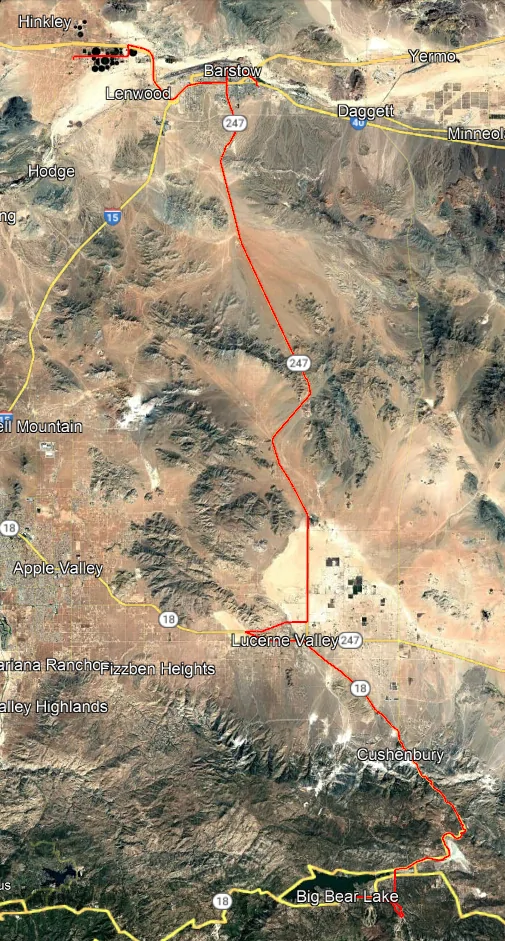

Day 2 – 9 Oct 2025 - Hinkley to Ridgecrest.
The day 2 ride is mostly west on CA Hwy 58 and north on US HWY 395. There is a lot of hill climbing and one steep drop. When passing through Kramer Junction, I looked at all three locations shown on PlugShare as future DCFC location. None show any indication that there will be anything there – yet. At Ridgecrest we camp in the county fairgrounds and as expected I was able to charge from a RV outlet. It was 208 volts unloaded and when charging about 195 volts so fairly slow with the mobile charge cord, but I was there for almost 16 hours so that did not matter. Because it was free, I charged to 100%.
Start of day: 78% - 221 miles
Day: 71.6 1.9 Mi/KWH
Trip: 237.2 2.1 Mi/KWH
End of day: 49% (did not note the GOM range)
Overnight charge 49% - 100% (66 KWH)
Overnight in Ridgecrest 35° 36' 44.86"N 117° 38' 46.69"W Ele. 2278'
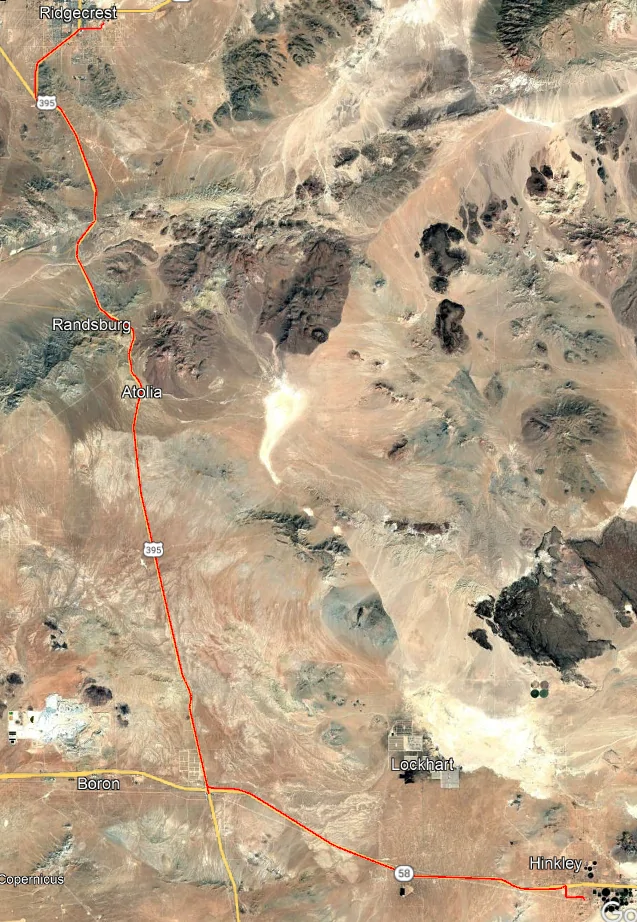

Day 3 – 10 Oct. 2025 - Ridgecrest to Lake Diaz (near Lone Pine)
Leaving Ridgecrest, we head west to InyoKern and then north on a side road to avoid the 396 traffic for a while. Across the street from our turn are three DCFC stations – two Tesla (both V3) with a 4 stall that is Tesla only and a 12 stall that is open to non-Tesla vehicles, and a 6 stall Rivian charger that is open to non-Rivian vehicles. The SuperCharger was my backup in case I had not been able to charge at the fairgrounds. Our lunch stop on day 3 is the Coso Junction rest area. The California Department of Transportation (CalTrans) has been installing free 50 KW EV chargers (one CCS-1 and one CHAdeMo cable) at many of the rest areas. Although I did not need a charge, I plugged in to make sure it worked. After lunch we continue up 395 to a small campground on the banks of Lake Diaz. It’s a fairly primitive campground with no power, so our dinner crew is dependent on the two food RVs for power for a table full of crock pots and an electric frying pan. A perpetual problem with that every year is tripping breakers on the RV circuit. To solve that problem, I ran my heavy duty 100 foot 120V extension cord over to the table and powered five of the crock pots and the frying pan from the bed inverter. In the morning, both Keurig coffee makers were plugged into my truck. Worked FAR better than the RV generators. Note, the problem was the breakers for the outside outlets, not generator capacity. Overnight, I sleep with a CPAP so that was plugged into the truck inverters. Because of the issue where the truck shuts off the inverters if there is not enough load when the truck is turned off, I left the truck on overnight with the stereo, climate, and displays off. Between the dinner, my overnight, and the coffee makers, I dropped 6% of battery capacity while in camp.
Start of day: 100% - 293 Mi. range
Day: 82.4 1.9 Mi/KWH
Trip: 319.6 2.0 Mi/KWH
End of day: 76% - 209 Mi range
Overnight at Lake Diaz 36° 33' 30.07"N 118° 03' 26.92"W Ele. 3690'
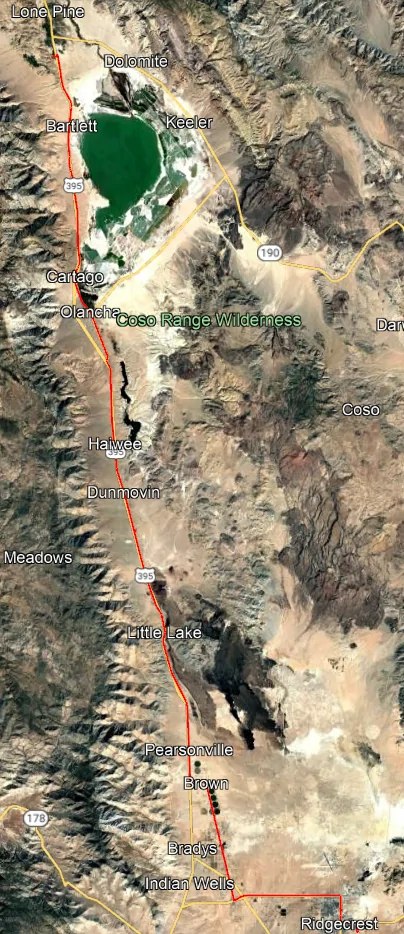

Day 4 – 11 Oct. 2025 - Lake Diaz to Bishop
The fourth day is mostly headed north on Hwy 395 then west in Bishop to a campground on the west end of town. Because of road construction, we could not get to our normal lunch stop, so we lunched at the Division Creek rest area. That location also has a CalTrans free 50 KW charger. It was available so I charged up until a Tesla M3 showed up. I asked the driver and he said it was pretty desperate for a charge so I unplugged so he could charge. See, I can be a nice guy… After lunch, headed north to Bishop. I had planned on topping off at the Tesla SuperCharger in town, but I was early and was able to plug in to the CalTrans 50KW charger at the District 9 office in the south end of town -free is better... Once I got set up in camp, I made a run over to the Verizon store because my cellphone was having a dying SIM card. Turns out that the 6 stall Rivian charger was in the same parking lot. That changer is open to non-Rivian vehicles. Back to camp and again I used the truck inverter to power my CPAP overnight.
Start of day: 70% - 186 Mi. range
Day: 68.9 2.0 Mi/KWH
Trip: 388.6 1.9 Mi/KWH
Division Creek rest area 59% - 94% (50 KWH)
CalTrans dist. 9 office 81% - 95% (21 KWH)
End of day: 93% - 256 Mi. range
Overnight in Bishop: 37° 21' 43.51"N 118° 26' 25.51"W Ele. 4322'
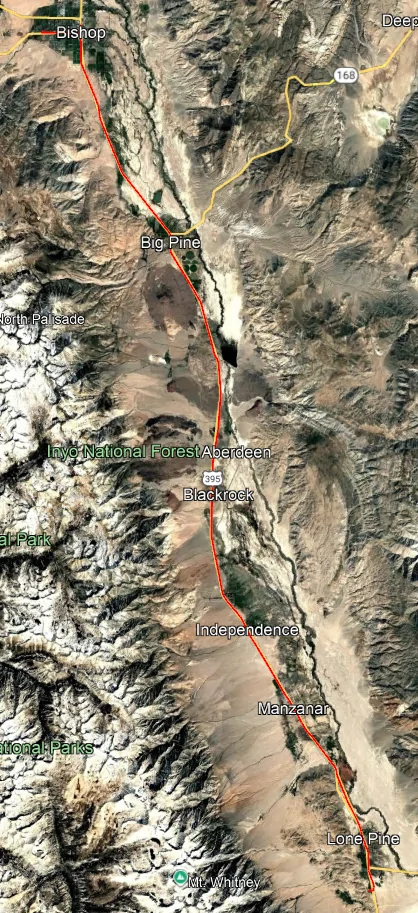

Day 5 – 12 Oct. - Bishop to Mammoth Mtn.
The last day of the ride takes the riders over the old road through Round Valley and Paradise rather than up Sherwin Grade on Hwy 395. This is a beautiful route and keeps the slow moving bikes off the fast traffic highway for most of the day. We lunch at Tom’s Place and then more side roads to keep the riders mostly off 395. All the bikes meet up in the town of Mammoth Lakes and ride up together to the Mammoth Mtn. Inn to complete the 335 mile ride. This is the shortest mileage day of the ride, but includes over a mile of climbing. I did have to carry one rider up to the meet up location than drove back to find both Tesla SuperChargers in town. One is an 8 stall V3 that is Tesla only and the other is 12 stall V3 that is open to non-Tesla vehicles. After checking out the chargers, I drove back a little ways to pick up another rider to take her to the meet up location. Then the last 4 miles up to the Mammoth Mtn. Inn.
Start of day: 87% - 225 miles
Day: 67.3 1.6 Mi/KWH
Trip: 455.9 1.8 Mi/KWH
End of day: 56% - 128 range
End of the ride: 37° 39' 04.10"N 119° 02' 14.05"W Ele. 8898'
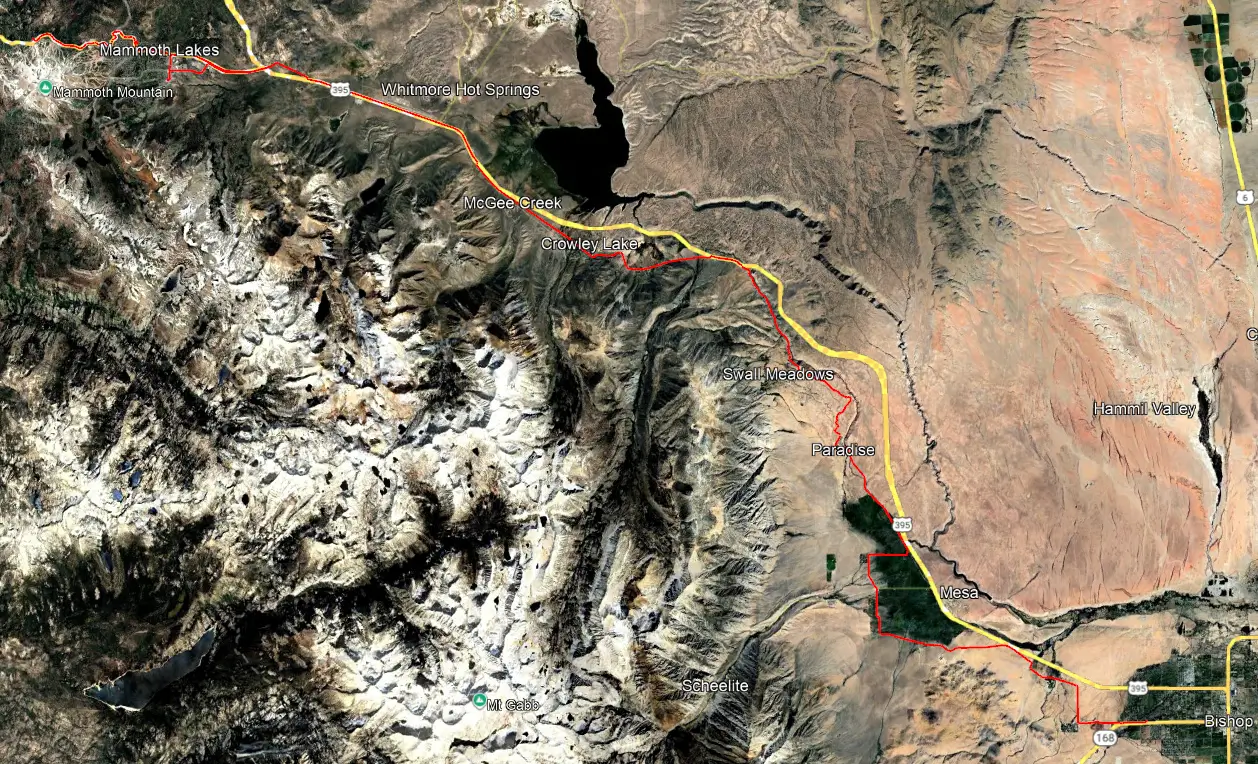

Day 6 – 13 Oct. 2025 - Mammoth Mtn to home
When I left Mammoth Mtn, it was 30 degrees in blowing snow. I was glad to get down a bit lower when the snow stopped. As I passed through Bishop I checked out the 24 stall Tesla SuperCharger on the north end of town that is open to non-Tesla vehicles, and the 4 stall E.A. charger. Both were completely vacant. After a stop at Erick Schat’s Bakkery for some great bread, I planned to stop by the CalTrans Dist. 9 office if it was available while I walked across the street for breakfast. But alas, another car just beat me to it, so I grabbed breakfast and continued south. Did some running around for some GeoCaching in Independence, around the Manzanar Relocation Center, and the north end of Lone Pine before pulling into the 16 stall V3 Tesla SuperCharger for lunch and a charge. I wanted to get enough charge to make it home so I charged to 95% Sure gets slow when the battery is that full! After the charge, did some more GeoCaching in Lone Pine before resuming the drive south. Several hours later I pulled into the Coso Junction rest area (for the facilities). The 50 KW charger was available so plugged in for the few minutes I was there. Did a little detour for a few GeoCaches in Randsburg and a dinner stop at Kramer Junction. Finally got home about 2115.
Start of day: 54% - 115 miles
Day: 330.4 2.3 Mi/KWH
Trip: 796.8 2.0 Mi/KWH
Tesla Lone Pine 17% - 95% (103 KWH)
Coso Junction rest area 77% - 82% (9 KWH)
End of day: 20% - 42 miles
When I got home I plugged into my FCSP to charge back to 100%
Home FCSP 20% - 100% (105 KWH)
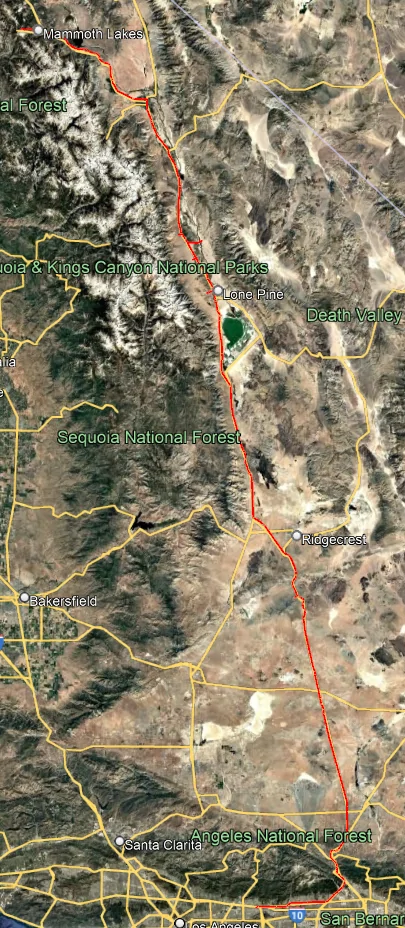

Charging summary (subscription with Tesla):
Barstow Tesla 52% - 83% (43 KWH) @ $0.43/KWH = $18.67 - Average rate 117.27 KW
Ridgecrest fairgrounds 49% - 100% (66 KWH) @ free - Average rate 4.53 KW
Coso Junction rest area 85% - 80% (7 KWH) @ free - Average rate 42.00 KW
Division Creek rest area 59% - 94% (50 KWH) @ free - Average rate 41.68 KW
CalTrans Dist. 9 office 81% - 95% (21 KWH) @ free - Average rate 38.38 KW
Lone Pine Tesla 17% - 95% (103 KWH) @ $0.46/KWH = $49.79 - Average rate 80.26 KW
Coso Junction rest area 77% - 83% (9 KWH) @ free - Average rate 41.54 KW
Home FCSP 20% - 100% (105 KWH) @ $0.27/KWH = $28.35
Peak charging rate at both Tesla chargers was about 185 KWH.
Having the Tesla subscription saved me $26.88 so more than paid for the monthly subscription cost – and I have another trip next weekend where I expect to charge twice at Tesla SuperChargers.
Total 796.8 miles using 404 KWH at a cost of $96.81. Average was 2.0 miles / KWH which is well below my average of 2.3 since I've owned the truck, but involved faster driving, lots of hills, leaving the climate control on most of the time I was on the road, and the in camp inverter loads.
Overall, it was a good trip. I was never at all concerned about being able to charge the truck.
Sponsored

